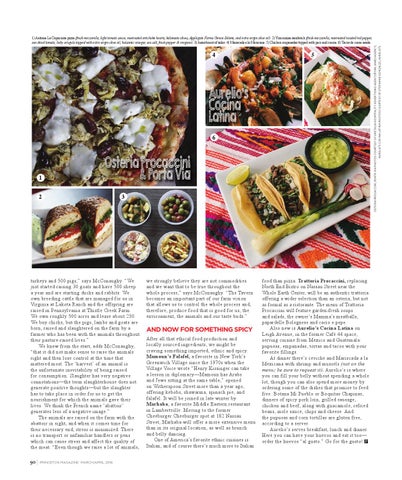4
osteria procaccini, porta via photos courtesy of gretalia hospitality advertising agency/ryan james agency; aurelio’s cocina latina photos courtesy of stephanie gonzalez, aurelio’s.
1) Antonia La Capriciosa pizza (fresh mozzarella, light tomato sauce, marinated artichoke hearts, kalamata olives, Applegate Farms Genoa Salami, and extra virgin olive oil). 2) Vincenzina sandwich (fresh mozzarella, marinated roasted red pepper, sun dried tomato, baby arugula topped with extra virgin olive oil, balsamic vinegar, sea salt, fresh pepper & oregano). 3) Assortment of sides. 4) Mariscada a la Mexicana. 5) Chicken empanadas topped with pico and crema. 6) Tacos de carne asada.
5
6
1 2
3
turkeys and 500 pigs,” says McConaughy. “We just started raising 30 goats and have 500 sheep a year and are starting ducks and rabbits. We own breeding cattle that are managed for us in Virginia at Lakota Ranch and the offspring are raised in Pennsylvania at Thistle Creek Farm. We own roughly 500 acres and lease about 250. We buy chicks, but the pigs, lambs and goats are born, raised and slaughtered on the farm by a farmer who has been with the animals throughout their pasture-raised lives.” We knew from the start, adds McConaughy, “that it did not make sense to raise the animals right and then lose control at the time that mattered most. The ‘harvest’ of an animal is the unfortunate inevitability of being raised for consumption. Slaughter has very negative connotations—the term slaughterhouse does not generate positive thoughts—but the slaughter has to take place in order for us to get the nourishment for which the animals gave their lives. We think the French name ‘abattoir’ generates less of a negative image.” The animals are raised on the farm with the abattoir in sight, and when it comes time for their necessary end, stress is minimized. There is no transport or unfamiliar handlers or pens which can cause stress and affect the quality of the meat. “Even though we raise a lot of animals,
90 |
we strongly believe they are not commodities and we want that to be true throughout the whole process,” says McConaughy. “The Tavern becomes an important part of our farm vision that allows us to control the whole process and, therefore, produce food that is good for us, the environment, the animals and our taste buds.”
AND NOW FOR SOMETHING SPICY After all that ethical food production and locally sourced ingredients, we might be craving something imported, ethnic and spicy. Mamoun’s Falafel, a favorite in New York’s Greenwich Village since the 1970s when the Village Voice wrote “Henry Kissinger can take a lesson in diplomacy—Mamoun has Arabs and Jews sitting at the same table,” opened on Witherspoon Street more than a year ago, offering kebobs, shawarma, spinach pie, and falafel. It will be joined in late winter by Marhaba, a favorite Middle Eastern restaurant in Lambertville. Moving to the former Cheeburger Cheeburger spot at 182 Nassau Street, Marhaba will offer a more extensive menu than in its original location, as well as brunch and belly dancing. One of America’s favorite ethnic cuisines is Italian, and of course there’s much more to Italian
food than pizza. Trattoria Procaccini, replacing North End Bistro on Nassau Street near the Whole Earth Center, will be an authentic trattoria: offering a wider selection than an osteria, but not as formal as a ristorante. The menu of Trattoria Procaccini will feature garden-fresh soups and salads, the owner’s Mamma’s meatballs, papardelle Bolognese and cacio e pepe. Also new is Aurelio’s Cocina Latina on Leigh Avenue, in the former Café 44 space, serving cuisine from Mexico and Guatemala: pupusas, empanadas, tortas and tacos with your favorite fillings. At dinner there’s ceviche and Mariscada a la Mexicana with shrimp and mussels (not on the menu; be sure to request it). Aurelio’s is where you can fill your belly without spending a whole lot, though you can also spend more money by ordering some of the dishes that promise to feed five: Botana Mi Pueblo or Boquitas Chapinas, dinners of spicy pork loin, grilled sausage, chicken and beef, along with guacamole, refried beans, mole sauce, chips and cheese. And the pupusas and corn tortillas are gluten free, according to a server. Aurelio’s serves breakfast, lunch and dinner. Here you can have your huevos and eat it too— order the huevos “al gusto.” Go for the gusto!
PRINCETON MAGAZINE MARCH/APRIL 2016
PM_FoodMecca.indd 6
3/4/16 2:05:56 PM
